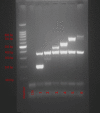Identification of Listeria Spp. Strains Isolated from Meat Products and Meat Production Plants by Multiplex Polymerase Chain Reaction
- PMID: 27800422
- PMCID: PMC5076688
- DOI: 10.4081/ijfs.2015.5498
Identification of Listeria Spp. Strains Isolated from Meat Products and Meat Production Plants by Multiplex Polymerase Chain Reaction
Abstract
Listeriosis is a foodborne disease caused by Listeria monocytogenes and is considered as a serious health problem, due to the severity of symptoms and the high mortality rate. Recently, other Listeria species have been associated with disease in human and animals. The aim of this study was to develop a multiplex polymerase chain reaction (PCR) in order to simultaneously detect six Listeria species (L. grayi, L. welshimeri, L. ivanovii, L. monocytogenes, L. seeligeri, L. innocua) in a single reaction. One hundred eighteen Listeria spp. strains, isolated from meat products (sausages) and processing plants (surfaces in contact and not in contact with meat), were included in the study. All the strains were submitted to biochemical identification using the API Listeria system. A multiplex PCR was developed with the aim to identify the six species of Listeria. PCR allowed to uniquely identify strains that had expressed a doubtful profile with API Listeria The results suggest that the multiplex PCR could represent a rapid and sensitive screening test, a reliable method for the detection of all Listeria species, both in contaminated food and in clinical samples, and also a tool that could be used for epidemiological purposes in food-borne outbreaks. A further application could be the development of a PCR that can be directly applied to the pre-enrichment broth.
Keywords: Listeria monocytogenes; Listeria spp; Meat products; Multiplex PCR.
Conflict of interest statement
the authors declare no potential conflict of interest.
Figures
Similar articles
-
Identification of six Listeria species by real-time PCR assay.Lett Appl Microbiol. 2014 Jun;58(6):535-40. doi: 10.1111/lam.12223. Epub 2014 Feb 24. Lett Appl Microbiol. 2014. PMID: 24461044
-
Isolation, identification, and characterization of Listeria spp. from various animal origin foods.Vet World. 2015 Jun;8(6):695-701. doi: 10.14202/vetworld.2015.695-701. Epub 2015 Jun 6. Vet World. 2015. PMID: 27065632 Free PMC article.
-
Comparison of multiplex PCR with conventional biochemical methods for the identification of Listeria spp. isolates from food and clinical samples in Queensland, Australia.J Food Prot. 2007 Aug;70(8):1874-80. doi: 10.4315/0362-028x-70.8.1874. J Food Prot. 2007. PMID: 17803144
-
Detection and differentiation of Listeria spp. by a single reaction based on multiplex PCR.Appl Environ Microbiol. 1999 Oct;65(10):4688-92. doi: 10.1128/AEM.65.10.4688-4692.1999. Appl Environ Microbiol. 1999. PMID: 10508109 Free PMC article.
-
Sensitive and specific detection of Listeria monocytogenes in milk and ground beef with the polymerase chain reaction.Appl Environ Microbiol. 1991 Sep;57(9):2576-80. doi: 10.1128/aem.57.9.2576-2580.1991. Appl Environ Microbiol. 1991. PMID: 1768130 Free PMC article.
Cited by
-
Novel Approaches to Environmental Monitoring and Control of Listeria monocytogenes in Food Production Facilities.Foods. 2022 Jun 15;11(12):1760. doi: 10.3390/foods11121760. Foods. 2022. PMID: 35741961 Free PMC article. Review.
-
Listeria Species Occurrence and Associated Factors and Antibiogram of Listeria monocytogenes in Beef at Abattoirs, Butchers, and Restaurants in Ambo and Holeta in Ethiopia.Infect Drug Resist. 2021 Apr 19;14:1493-1504. doi: 10.2147/IDR.S304871. eCollection 2021. Infect Drug Resist. 2021. PMID: 33907427 Free PMC article.
-
Evaluation of vacuum packaging for extending the shelf life of Sardinian fermented sausage.Ital J Food Saf. 2023 Jun 8;12(2):10819. doi: 10.4081/ijfs.2023.10819. eCollection 2023 Jun 8. Ital J Food Saf. 2023. PMID: 37405145 Free PMC article.
-
Verification of a Rapid Analytical Method for the Qualitative Detection of Listeria spp. and Listeria monocytogenes by a Real-Time PCR Assay according to EN UNI ISO 16140-3:2021.Pathogens. 2024 Feb 4;13(2):141. doi: 10.3390/pathogens13020141. Pathogens. 2024. PMID: 38392879 Free PMC article.
References
-
- Allerberger F, 2007. Listeria. Foodborne diseases. Humana Press, Totowa, NJ, USA.
-
- Allerberger F, Wagner M, 2010. Listeriosis: a resurgent foodborne infection. Clin Microbiol Infec 16:16-23. - PubMed
-
- Aureli P, Fiorucci GC, Caroli D, Marchiaro G, Novara O, Leone L, Salmaso S, 2000. An outbreak of febrile gastroenteritis associated with corn contaminated by Listeria monocytogenes. New Engl J Med 27:1236-41. - PubMed
-
- Cornu M, Kalmokoff M, Flandrois JP, 2002. Modelling the competitive growth of Listeria monocytogenes and Listeria innocua in enrichment broths. Int J Food Microbiol 73:261-74. - PubMed
LinkOut - more resources
Full Text Sources
Other Literature Sources
Molecular Biology Databases
Miscellaneous


